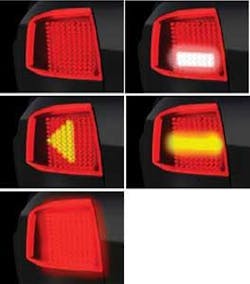SOLID-STATE LIGHTING: Tomorrow’s light could get moody

Several of the presentations at the Strategies in Light 2008 conference (Feb. 11-13, Santa Clara, CA; www.strategiesinlight.com) touched on the concept of “intelligent light”—the combination of software—either internal (embedded) or external—with solid-state light sources. From “local dimming” of LED television displays to enhance the viewing experience, to automobile lighting that self-adjusts to meet varying driving situations, intelligent light will enable a host of novel (and previously impossible) approaches to the way in which lighting and illumination is applied.
In fact, keynote speaker Bas van de Kieft of Philips Lighting cautioned against “myopia” in this regard. Noting that early versions of the motor car were based simply on existing (horse drawn) carriage designs in which an engine was installed, van de Kieft suggested that one-for-one replacement of today’s light bulbs with LED-based bulbs is short-term thinking, and the real benefit of solid-state lighting will come in the future from innovative out-of-the-box applications.
Now in its ninth year, Strategies in Light 2008, whose theme was “Emerging Applications Driving the LED Market Forward,” provided some interesting insights into the rapidly developing trends in applications, markets, products, and technologies that will affect the industry’s future. It is the leading event in the world of light-emitting diodes (LEDs) and this year attracted more than 1500 people from 28 countries to an exhibition and conference at the Santa Clara, CA, convention center.
A healthy market
According to analyst Bob Steele of Strategies Unlimited (Mountain View, CA), who organized the event, the global market for high-brightness LEDs has apparently recovered from its “slow growth” phase of 2004 to 2006. Steele, who opened the conference with a review and forecast of the global LED market, noted that demand for LEDs is currently healthy across all applications with global revenues gaining 9.5% in 2007 to reach $4.6 billion. Price erosion is significant, he said, so units actually grew 26% to reach 39 billion.
The mobile appliances segment, which includes mobile phones, accounted for 39% of high-brightness LED sales in 2007, a share that is buoyed by LED sales for phone-camera flash and other mobile devices, despite the maturing phone market. Other applications segments include illumination (37%), signs and displays (8%), signals (6%), and automotive (4%). Highest growth segments in 2007 were signs and displays, illumination, and automotive.
On the automotive front, market penetration of LEDs is expanding but there is no comprehensive approach by automakers to LED adoption. Their use is determined on a model-by-model basis by styling requirements, reliability issues, functionality, and cost, said Steele. Last year saw the introduction of the first production vehicle (Lexus) with LED headlights (low beam only) and 2008 will bring low- and high-beam LED headlights from Audi and Cadillac.
In his presentation, “LEDs in the Automotive Environment: Possibilities and Opportunities,” Luis Sampedro Diaz of Volkswagen America’s Electronics Research Laboratory (ERL; Palo Alto, CA) described some of the work being done with LEDs at his lab. The “holy grail,” he said, of automotive LED development is dynamic lighting with no moving parts. Examples include intelligent high-beam headlights with addressable LED chips that provide drivers with dynamic and selective light distribution in real time; intelligent tail lights that immediately adapt to varying ambient conditions (such as fog) by changing their intensity; and—believe it or not—software-controlled styling that allows drivers to “express their mood” by, for example, instantly changing the shape of the rear turn signal (see figure).
The LED lighting market in 2007 was $330 million (a 60% increase from 2006) and is projected to grow to $1.4 billion in 2012. Steele noted that many companies are now entering the market with new products and ideas, especially with luminaires and fixtures. Standards are at last being finalized, he said, which should help accelerate adoption and growth of LED lighting. But he also cautioned that luminaire product quality and efficiency is highly variable with many poorly performing products coming to market.
Looking forward, Steele highlighted several issues and opportunities for solid-state lighting. The high initial cost of LED lighting will likely deter initial adoption unless products can deliver value on a cost-of-ownership basis, he said. However, one of the major market drivers will be energy efficiency (a theme that spanned many other presentations) and the market will likely get a boost from government subsidies related to the phase out of energy hungry incandescent bulbs.
Energy efficiency (extended battery life) is also a factor in the penetration of LEDs into notebook PC displays, which hit 3.2% in 2007—an increase from 0.7% in 2006. Other market drivers are lower weight, and their slim profile, but cost is an issue. Existing cold-cathode fluorescent-based backlights are cheaper and offer a better color gamut than today’s white-light LEDs. Nonetheless Steele expects penetration to continue growing in 2008 to reach 10%.
About the Author
Stephen G. Anderson
Director, Industry Development - SPIE
Stephen Anderson is a photonics industry expert with an international background and has been actively involved with lasers and photonics for more than 30 years. As Director, Industry Development at SPIE – The international society for optics and photonics – he is responsible for tracking the photonics industry markets and technology to help define long-term strategy, while also facilitating development of SPIE’s industry activities. Before joining SPIE, Anderson was Associate Publisher and Editor in Chief of Laser Focus World and chaired the Lasers & Photonics Marketplace Seminar. Anderson also co-founded the BioOptics World brand. Anderson holds a chemistry degree from the University of York and an Executive MBA from Golden Gate University.